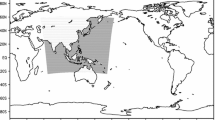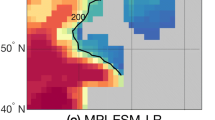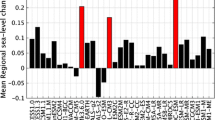Abstract
The Southeast Asian Monsoon (SEAM) is strongly affected by the complex topography and land–sea interface over Southeast Asia (SEA), which combine to make simulation of the SEAM technically challenging. To adequately assess the regional climate change signal, we have employed the Weather Research and Forecasting (WRF) Model to dynamically downscale a global climate change projection produced with the Community Earth System Model using different physics configurations in WRF, constituting a 5-member physics mini-ensemble. All ensemble members consistently project an increase in average SEAM rainfall and an increase in the frequency of extreme events. A regional ocean model based upon the Coastal and Regional Ocean Community model system was then incorporated into the dynamical downscaling pipeline and this has also contributed to significantly further improving the simulations of both sea surface temperature and SEAM rainfall. Since the Tibetan Plateau (TP) is widely considered to act as an elevated heat source which contributes to driving the Asian monsoon system, a coupled dynamically downscaled simulation with flattened plateau has also been performed so as to investigate the role of TP in the SEAM at a higher spatial resolution than has previously been investigated. Significant decrease of precipitation and winds over SEA, as well as a later monsoon onset by 1 month, are documented for the no TP experiment. Extreme precipitation is less affected than average precipitation. Such changes are more important for the northern part of the domain and are significantly amplified in the dynamically downscaled WRF simulations when compared with the global simulations that employ significantly coarser resolution.















Similar content being viewed by others
References
Abe M, Yasunari T, Kitoh A (2004) Effects of large-scale orography on the coupled atmosphere–ocean system in the tropical Indian and Pacific oceans in boreal summer. J Meteorol Soc Jpn 82:745–759
Allen MR, Ingram WJ (2002) Constraints on future changes in climate and the hydrologic cycle. Nature 419:224–232
An Z, Kutzbach J, Prell W, Porter S (2001) Evolution of Asian monsoons and phased uplift of the Himalaya–Tibetan plateau since Late Miocene times. Nature 411:62–66
Baldwin JW, Vecchi GA, Bordoni S (2019) The direct and ocean-mediated influence of Asian topography on tropical precipitation and cyclones. Clim Dyn 53:805–824
Berg P, Haerter JO (2013) Unexpected increase in precipitation intensity with temperature—a result of mixing of precipitation types? Atmos Res 119:56–61
Boos WR, Hurley JV (2013) Thermodynamic bias in the Multimodel Mean Boreal Summer Monsoon. J Clim 26:2279–2287
Boos WR, Kuang ZM (2010) Dominant control of the South Asian monsoon by orographic insulation versus plateau heating. Nature 463:218–222
Broccoli AJ, Manabe S (1992) The effects of orography on mid-latitude northern hemisphere dry climates. J Clim 5:1181–1201
Chen GS, Liu Z, Kutzbach J (2014) Reexamining the barrier effect of the Tibetan Plateau on the South Asian summer monsoon. Clim Past 10(3):1269–1275
Chotamonsak C, Salathé EP, Kreasuwan J, Chantara S, Siriwitayakorn K (2011) Projected climate changeover Southeast Asia simulated using a WRF regional climate model. Atmos Sci Lett 12(2):213–219
Christensen JH, Krishna Kumar K, Aldrian E, An SI, Cavalcanti IFA, de Castro M, Dong W, Goswami P, Hall A, Kanyanga J, Kitoh A, Kossin J, Lau NC, Renwick J, Stephenson DB, Xie SP, Zhou T (2013) Climate phenomena and their relevance for future regional climate change. In: Stocker TF et al (eds) Climate change 2013: the physical science basis. contribution of Working Group I to the fifth assessment report of the intergovernmental panel on climate change. Cambridge University Press, Cambridge, pp 1217–1308
Clapeyron MC (1834) Mémoire sur la puissance motrice de la chaleur. J Écol Polytech 23:153–193 (in French)
Clausius R (1850) On the motive power of heat and the laws which can be deduced therefrom regarding the theory of heat. Ann Phys 155:500–524
Craig A, Valcke S, Coquart L (2017) Development and performance of a new version of the OASIS coupler, OASIS3-MCT_3.0. Geosci Model Dev 10(9):3297–3308
Debreu L, Marchesiello P, Penven P, Cambon G (2012) Two-way nesting in split-explicit ocean models: algorithms, implementation and validation. Ocean Model 49–50:1–21
d’Orgeville M, Peltier WR, Erler AR, Gula J (2014) Climate change impacts on Great Lakes Basin precipitation extremes. J Geophys Res 119(18):10 799–710 812
Endo H, Kitoh A, Ose T, Mizuta R, Kusunoki S (2012) Future changes and uncertainties in Asian precipitation simulated by multi-physics and multi-sea surface temperature ensemble experiments with high-resolution Meteorological Research Institute atmospheric general circulation models (MRI-AGCMs). J Geophys Res 117:D16118
Eggert B, Berg P, Haerter J, Jacob D, Moseley C (2015) Temporal and spatial scaling impacts on extreme precipitation. Atmos Chem Phys 15:5957–5971
Endo N, Matsumoto J, Lwin T (2009) Trends in precipitation extremes over Southeast Asia. Sola 5:168–171
Erler AR, Peltier WR (2016) Projected changes in precipitation extremes for Western Canada based on high-resolution regional climate simulations. J Clim 29:8841–8863
Flohn H (1968) Contributions to a Meteorology of the Tibetan Highlands. Tech Rep 130, Colorado State Univ
Gent PR, Danabasoglu G, Donner LJ, Holland MM, Hunke EC, Jayne SR, Lawrence DM, Neale RB, Rasch PJ, Vertenstein M, Worley PH, Yang Z-L, Zhang M (2011) The community climate system model version 4. J Clim 24(19):4973–4991
Ghosh S, Mujumdar PP (2009) Climate change impact assessment: uncertainty modeling with imprecise probability. J Geophys Res 114:20
Grell GA, Freitas SR (2014) A scale and aerosol aware stochastic convective parameterization for weather and air quality modeling. Atmos Chem Phys 14:5233–5250
Gula J, Peltier WR (2012) Dynamical downscaling over the Great Lakes Basin of North America using the WRF regional climate model: the impact of the Great Lakes system on regional greenhouse warming. J Clim 25:7723–7742
Hahn DG, Manabe S (1975) The role of mountains in the south Asian monsoon circulation. J Atmos Sci 32:1515–1541
Harris I, Osborn TJ, Jones P et al (2020) Version 4 of the CRU TS monthly high-resolution gridded multivariate climate dataset. Sci Data 7:109
Hartigan JA, Wong MA (1979) Algorithm AS 136: a K-means clustering algorithm. J R Stat Soc 28C:100–108
Held IM, Soden BJ (2006) Robust responses of the hydrological cycle to global warming. J Clim 19:5686–5699
Hong SY, Dudhia J, Chen SH (2004) A revised approach to ice microphysical processes for the bulk parameterization of clouds and precipitation. Mon Weather Rev 132:103–120
Hong SY, Lim JOJ (2006) The WRF single-moment 6-class microphysics scheme (WSM6). J Korean Meteorol Soc 42:129–151
Huo Y, Peltier WR (2019) Dynamically downscaled climate simulations of the Indian Monsoon in the instrumental era: physics parameterization impacts and precipitation extremes. J Appl Meteorol Climatol 58(4):831–852
Huo Y, Peltier WR (2020) Dynamically downscaled climate change projections for the South Asian Monsoon: mean and extreme precipitation changes and physics parameterization impacts. J Clim 33:2311–2331
Iacono MJ, Delamere JS, Mlawer EJ, Shephard MW, Clough SA, Collins WD (2008) Radiative forcing by long–lived greenhouse gases: calculations with the AER radiative transfer models. J Geophys Res 113:D13103
IPCC (2013) Summary for policymakers climate change 2013: the physical science basis. Contribution of Working Group I to the Fifth Assessment Report of the Intergovernmental Panel on Climate Change. Cambridge University Press, Cambridge
IPCC (2014) Climate change 2014: impacts, adaptation, and vulnerability. Part B: regional aspects Contribution of Working Group II to the Fifth Assessment Report of the Intergovernmental Panel on Climate Change. Cambridge University Press, Cambridge
Janjic ZI (1994) The step–mountain eta coordinate model: further developments of the convection, viscous sublayer, and turbulence closure schemes. Mon Weather Rev 122:927–945
Kain JS (2004) The Kain–Fritsch convective parameterization: an update. J Appl Meteorol 43:170–181
Katz RW (2010) Statistics of extremes in climate change. Clim Change 100:71–76
Kim IW, Oh J, Woo S, Kripalani RH (2019) Evaluation of precipitation extremes over the Asian domain: observation and modelling studies. Clim Dyn 52:1317–1342
Kitoh A (2002) Effects of large-scale mountains on surface climate—a coupled ocean–atmosphere general circulation model study. J Meteorol Soc Jpn 80:1165–1181
Kitoh A (2017) The Asian monsoon and its future change in climate models: a review. J Meteorol Soc Jpn Ser II 95(1):7–33
Kutzbach JE, Guetter PJ, Ruddiman WF, Prell WL (1989) Sensitivity of climate to late Cenozoic uplift in southern Asia and the American west: numerical experiments. J Geophys Res Atmos 94:18393–18407
Kutzbach JE, Prell WL, Ruddiman WF (1993) Sensitivity of Eurasian climate to surface uplift of the Tibetan Plateau. J Geol 101:177–190
Manomaiphiboon K, Octaviani M, Torsri K, Towprayoon S (2013) Projected changes in means and extremes of temperature and precipitation over Thailand under three future emissions scenarios. Clim Res 58(2):97–115
Menne MJ, Durre I, Vose RS, Gleason BE, Houston TG (2012) An overview of the global historical climatology network-daily database. J Atmos Ocean Technol 29(7):897–910
Molnar P, England P, Martinod J (1993) Mantle dynamics, uplift of the Tibetan Plateau, and the Indian monsoon. Rev Geophys 31:357–396
Nakanishi M, Niino H (2009) Development of an improved turbulence closure model for the atmospheric boundary layer. J Meteorol Soc Jpn 87:895–912
Niu GY, Yang ZL, Mitchell KE, Chen F, Ek MB, Barlage M, Kumar A, Manning K, Niyogi D, Rosero E, Tewari M, Xia Y (2011) The community Noah land surface model with multiparameterization options (Noah–MP): 1. Model description and evaluation with local-scale measurements. J Geophys Res 116:D12109
Peltier WR, d’Orgeville M, Erler AR, Xie F (2018) Uncertainty in future summer precipitation in the Laurentian Great Lakes Basin: dynamical downscaling and the influence of continental scale processes on regional climate change. J Clim 31:2651–2673
Prive NC, Plumb RA (2007) Monsoon dynamics with interactive forcing. Part II: Impact of eddies and asymmetric geometries. J Atmos Sci 64:1431–1442
Reynolds RW, Rayner NA, Smith TM, Stokes DC, Wang W (2002) An improved in situ and satellite SST analysis for climate. J Clim 15:1609–1625
Rodwell MJ, Hoskins BJ (1996) Monsoons and the dynamics of deserts. Q J R Meteorol Soc 122:1385–1404
Rodwell MJ, Hoskins BJ (2001) Subtropical anticyclones and summer monsoons. J Clim 14:3192–3211
Shchepetkin AF, McWilliams JC (2005) The regional ocean modeling system: a split-explicit, free‐surface, topography following coordinates ocean model. Ocean Model 9:347–404
Skamarock WC, Klemp JB (2008) A time-split nonhydrostatic atmospheric model for weather research and forecasting applications. J Comput Phys 227:3465–3485
Thuy LTT, Kawagoe S, Sarukkalige R (2019) Estimation of probable maximum precipitation at three provinces in Northeast Vietnam using historical data and future climate change scenarios. J Hydrol Reg Stud 23:20
Tiedtke M (1989) A comprehensive mass flux scheme for cumulus parameterization in large-scale models. Mon Weather Rev 117:1779–1800
Utsumi N, Seto S, Kanae S, Maeda EE, Oki T (2011) Does higher surface temperature intensify extreme precipitation? Geophys Res Lett 38:1–5
Valcke S (2013) The OASIS3 coupler: a European climate modelling community software. Geosci Model Dev 6(2):373–388
Wu G, Liu Y, He B et al (2012) Thermal controls on the Asian Summer Monsoon. Sci Rep 2:404
Yasunari T, Saito K, Takata K (2006) Relative roles of large-scale orography and land surface processes in the global hydroclimate. Part I: Impacts on monsoon systems and the tropics. J Hydrometeorol 7:626–641
Yusuf AA, Francisco HA (2009) Climate change vulnerability mapping for Southeast Asia economy and environment program for Southeast Asia (EEPSEA). Singapore
Acknowledgements
The authors thank Dr. A. Erler for assistance with the setup of the CESM1-WRF modeling chain. Furthermore, the help of Mr. F. Xie in coupling CROCO into the dynamical downscaling system was valuable and is gratefully acknowledged. The simulations presented in this paper were performed at the SciNet High Performance Computing facility at the University of Toronto, which is a component of the Compute Canada HPC platform. The research of WRP at the University of Toronto is supported by NSERC Discovery Grant 9627. (The CRU TS3.10, GHCN daily observational datasets and the OISST2 data set employed in this study are publicly available online at http://www.cru.uea.ac.uk/cru/data/hrg/, https://www.ncdc.noaa.gov/ghcnd-data-access and http://icdc.cen.uni-hamburg.de/1/daten/ocean/sst-reynolds/, respectively.)
Author information
Authors and Affiliations
Corresponding author
Additional information
Publisher’s note
Springer Nature remains neutral with regard to jurisdictional claims in published maps and institutional affiliations.
Electronic Supplementary Material
Below is the link to the electronic supplementary material.
Rights and permissions
About this article
Cite this article
Huo, Y., Peltier, W.R. The southeast asian monsoon: dynamically downscaled climate change projections and high resolution regional ocean modelling on the effects of the Tibetan Plateau. Clim Dyn 56, 2597–2616 (2021). https://doi.org/10.1007/s00382-020-05604-9
Received:
Accepted:
Published:
Issue Date:
DOI: https://doi.org/10.1007/s00382-020-05604-9




